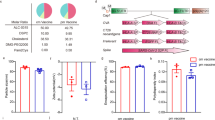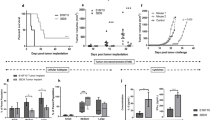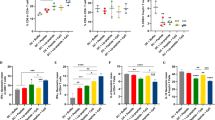Abstract
DNA-based vaccine immunization effectively induces both humoral and cell-mediated immunity to antigens and can confer protection against numerous infectious diseases as well as some cancers. Human and mouse melanomas consistently express the tumor-associated antigen interacted with the melanogenesis pathway. Gp100 is immunogenic and has been shown to induce both antibody and cytotoxic T cell (CTL) responses in humans. To explore the potential use of DNA immunization to induce melanoma-specific immune responses, we assessed HVJ-AVE liposome incorporated with plasmid DNA encoding human gp100. The gp100 DNA vaccine was used in a mouse melanoma model to assess immunity against the B16 melanoma of C57BL/6 mice. Intramuscular injection of the DNA–HVJ-AVE liposomes induced both anti-gp100 antibody and CTL responses. Gp100 DNA–HVJ-AVE liposome immunization significantly delayed tumor development in mice challenged with B16 melanoma cells. Mice immunized with gp100 DNA–HVJ-AVE liposomes survived longer compared with control mice immunized with HVJ-AVE liposome alone. These results indicate that immunization with human gp100 DNA by HVJ-AVE liposomes can induce protective immunity against melanoma in this pre-clinical mouse model. This strategy may provide an effective approach for vaccine therapy with tumor-associated antigens against human melanoma.
This is a preview of subscription content, access via your institution
Access options
Subscribe to this journal
Receive 12 print issues and online access
$259.00 per year
only $21.58 per issue
Buy this article
- Purchase on Springer Link
- Instant access to full article PDF
Prices may be subject to local taxes which are calculated during checkout




Similar content being viewed by others
References
Ho TY et al. DNA vaccination induces a long-term antibody response and protective immunity against pseudorabies virus in mice Arch Virol 1998 143: 115–125
Larsen DL et al. Coadminstration of DNA encoding interleukin-6 and hemagglutinin confers protection from influenza virus challenge in mice J Virol 1998 72: 1704–1708
Iwasaki A, Barber BH . Induction by DNA immunization of a protective antitumor cytotoxic T lymphocyte response against a minimal-epitope-expressing tumor Cancer Immunol Immunother 1994 45: 273–279
Chen Y et al. DNA vaccines encoding full-length or truncated Neu induce protective immunity against Neu-expressing mammary tumors Cancer Res 1998 58: 1965–1971
Schreurs MWJ, de Boer A, Figdor CG, Adema GJ . Genetic vaccination against the melanocyte lineage-specific antigen gp100 induces cytotoxic T lymphocyte-mediated protection Cancer Res 1998 58: 2509–2514
Kawakami Y et al. Identification of a human melanoma antigen recognized by tumor-infiltrating lymphocytes associated with in vivo tumor rejection Proc Natl Acad Sci USA 1994 91: 6458–6462
Zhai Y et al. Antigen-specific tumor vaccines: development and characterization of recombinant adenoviruses encoding MART1 or gp100 for cancer therapy J Immunol 1996 156: 700–710
Huang SKS et al. Antibody responses to melanoma/melanocyte auto-antigens in melanoma patients J Invest Dermatol 1998 111: 662–667
Zhai Y et al. Cloning and characterization of the genes encoding the mouse homologues of the human melanoma antigen MART 1 and gp100 J Immunother 1997 20: 15–25
Sarantou T et al. Melanoma-associated antigen as messenger RNA detection markers for melanoma Cancer Res 1997 57: 1371–1376
Okamoto T et al. Induction of antibody response to human tumor antigens by gene therapy using a fusigenic viral liposome vaccine Gene Therapy 1997 4: 969–976
Hirano K et al. Persistent gene expression in rat liver in vivo by repetitive transfections using HVJ-liposome Gene Therapy 1998 5: 459–464
Saeki Y et al. Development and characterization of cationic liposomes conjugated with HVJ (Sendai virus): reciprocal effect of cationic lipid for in vivo and in vitro gene transfer Hum Gene Ther 1997 8: 2133–2141
Nakanishi M et al. Efficient induction of contents of liposomes into cells using HVJ (Sendai virus) Exp Cell Res 1985 159: 399–409
Kaneda Y et al. The improved efficient method for introducing macromolecules into cells using HVJ (Sendai virus) liposomes with gangliosides Exp Cell Res 1987 173: 56–69
Kaneda Y Iwai K, Uchida T . Increased expression of DNA cointroduced with nuclear protein in adult rat liver Science 1989 243: 375–378
Kaneda Y, Iwai K, Uchida T . Introduction and expression of the human Insulin gene in adult rat liver J Biol Chem 1989 264: 12126–12129
Morishita R et al. Single intraluminal delivery of antisense cdc2 kinase and proliferating-cell nuclear antigen oligonucleotides results in chronic inhibition of neointimal by perplasia Proc Natl Acad Sci USA 1993 90: 8474–8478
Morishita R et al. Novel and effective gene transfer technique for study of vascular renin angiotensin system J Clin Invest 1993 91: 2580–2585
Hoon DSB, Irie RF . Current status of human melanoma vaccines Can they control malignant melanoma? BioDrugs 1997 1: 66–84
Morton DL et al. Prolongation of survival in metastatic melanoma after active specific immunotherapy with new polyvalent melanoma vaccine Ann Surg 1992 216: 463–482
Baniyash M et al. Serologically detectable MHC and tumor-associated antigens on B16 melanoma variants and humoral immunity in mice bearing these tumors J Immunol 1982 129: 1318–1323
Schearer GM, Rehn TG, Garbarino CA . Cell-mediated lympholysis of trinitrophenyl-modified autologous lymphocytes J Exp Med 1975 141: 1348–1364
Zinkernagel RM, Dohetry OC . Restriction of in vitro T cell-mediated cytotoxicity in lymphocytic chorio-meningitis within a syngenic or semiallogenic system Nature 1974 248: 701–702
Acknowledgements
This work was supported by a grant for an international joint work provided by the Ministry of Education, Science and Culture of Japan.
Author information
Authors and Affiliations
Rights and permissions
About this article
Cite this article
Zhou, WZ., Kaneda, Y., Huang, S. et al. Protective immunization against melanoma by gp100 DNA–HVJ-liposome vaccine. Gene Ther 6, 1768–1773 (1999). https://doi.org/10.1038/sj.gt.3300998
Received:
Accepted:
Published:
Issue Date:
DOI: https://doi.org/10.1038/sj.gt.3300998
Keywords
This article is cited by
-
Targeting the tumor microenvironment by liposomal Epacadostat in combination with liposomal gp100 vaccine
Scientific Reports (2023)
-
Nanotechnology in the arena of cancer immunotherapy
Archives of Pharmacal Research (2020)
-
A new marine-derived sulfoglycolipid triggers dendritic cell activation and immune adjuvant response
Scientific Reports (2017)
-
Local and systemic effect of transfection-reagent formulated DNA vectors on equine melanoma
BMC Veterinary Research (2015)
-
Local and systemic effect of transfection-reagent formulated DNA vectors on equine melanoma
BMC Veterinary Research (2015)



